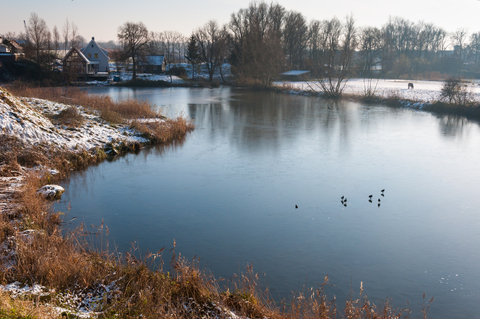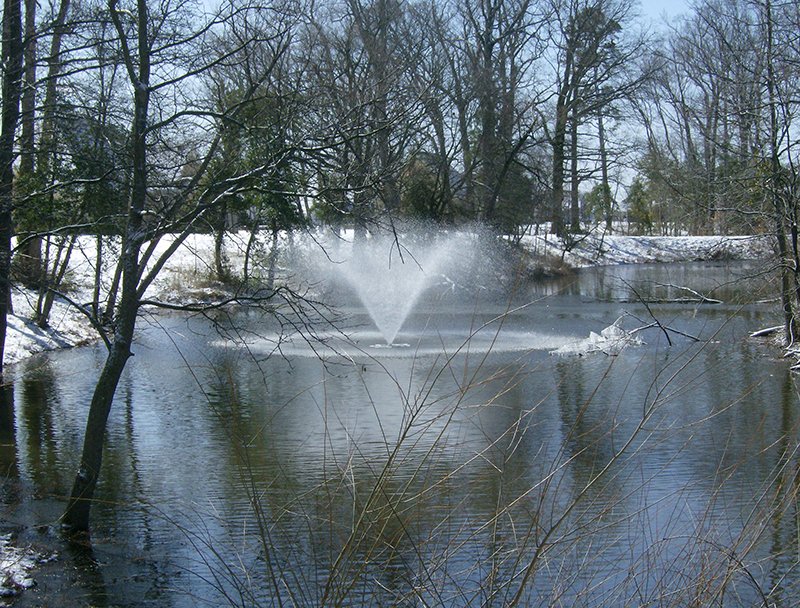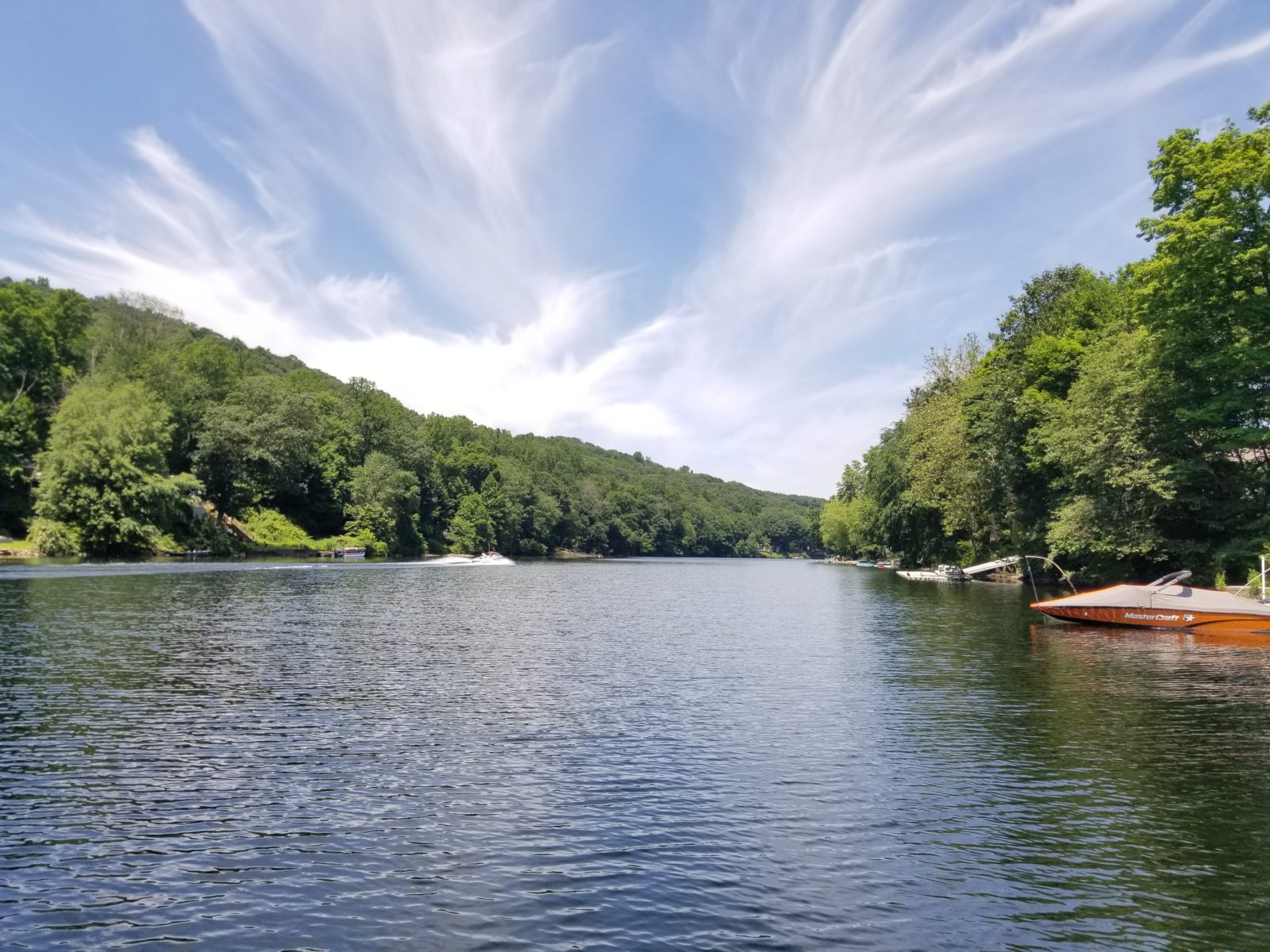Important Pond Winterizing Tips For Proper Pond Management
December 3rd, 2013
Written by Industry Expert John Phelps, Environmental Scientist
Winter weather can wreak havoc on the spring and summer beauty and function of a lake, pond, or water feature. In fact, proper winterizing procedures are one of the best things you can do for a clear and healthy lake or pond next season. A few key preparatory measures will provide a balanced aquatic ecosystem where fish and plants can survive the winter and be kept in top condition for the following season. Keep in mind that winterizing techniques are highly variable depending on geographic location, volume, depth, and source of water among other factors. Your lake or pond professional should have all information needed in your area to treat your lake or pond appropriately. The majority of techniques described in this article apply to lakes or ponds.

WHEN TO START WINTERIZINGYou can start your winterizing processes when the water temperature begins to approach 60 degrees. This could be late fall to early winter. However, before the water’s temperature dips below 60, you will want to clear up any visible remaining algae or weeds. For less regrowth in the spring, try to eliminate aquatic nuisances in the fall by removing organic debris, aerating, managing weeds, and performing routine maintenance.
MANAGE ORGANIC DEBRIS Organic debris develops during the fall and winter and its decay helps to load the system with excess nutrients and depletes the water of oxygen which causes algae, aquatic weeds, fish kills and odors. Leaves, sticks and any other floating or submerged organic material should be removed. Make sure your homeowners and landscapers never blow leaves or grass clippings into the water or the storm drains, gutters, and ditches that lead to the lake or pond.
AERATE TO INCREASE OXYGEN AND WATER FLOW There are a several reasons for winter pond aeration: to increase oxygen levels to prevent winter fish kills, to keep areas of water open for winter waterfowl and other wildlife, and to prevent freezing. Most importantly, aeration will help to remediate the accumulation of organic matter and fertilizer runoff that does ultimately flow into the lake or pond before it becomes fuel for algae growth the following spring. Depending on the pond’s depth and shape as well as one’s personal preference, a floating fountain or submersed air diffused aerator can serve to aerate a pond. Your lake and pond management professional can help you determine the ideal type, quantity and location(s) for achieving proper aeration.
There are a several reasons for winter pond aeration: to increase oxygen levels to prevent winter fish kills, to keep areas of water open for winter waterfowl and other wildlife, and to prevent freezing. Most importantly, aeration will help to remediate the accumulation of organic matter and fertilizer runoff that does ultimately flow into the lake or pond before it becomes fuel for algae growth the following spring. Depending on the pond’s depth and shape as well as one’s personal preference, a floating fountain or submersed air diffused aerator can serve to aerate a pond. Your lake and pond management professional can help you determine the ideal type, quantity and location(s) for achieving proper aeration.
If your aeration method is a floating fountain and you are considering removing it from your frigid pond this winter, PONDer this thought: There is one solid and tested solution for keeping a fountain running through the bitter months of winter regardless of how cold it gets. Bottom diffused aeration systems make a perfect companion to a fountain. When placed directly under a fountain, this constant stream of air will prevent the water, directly around the fountain, from freezing all winter. This coupling of aeration systems will keep your beautiful fountain running all year long, and will also provide a dramatic increase in water quality due to the supplemental benefits of bottom diffused aeration.
MANAGE AQUATIC WEEDSYour lake or pond service provider should have an Integrated Pest Management (IPM) plan for your lake which includes using aquatic herbicides for aquatic weed control. One simple improvement that can be made to many lake or pond management programs to help reduce the dependence on aquatic herbicides for control of nuisance and invasive aquatic weeds is the introduction of sterile grass carp. Now is a great time to consider stocking these fish to help manage this unwanted growth in the coming season. Utilizing sterile grass carp in combination with sustainable herbicide application techniques makes for an ideal management strategy.
PERFORM SURVEYS AND MAINTENANCEEarly winter, before the frigid weather comes, is a wonderful time to evaluate problems from the previous year, devise a mitigation plan for the upcoming year, and make improvements to your lake or pond that will pay huge dividends next spring.
There are two diagnostic tools that are recommended in the winter: pond survey and bathymetric survey. An inexpensive pond survey is performed using GPS technology to identify erosion problems along banks or damage from nuisance wildlife, inspect structural components and identify areas of the basin with major sediment accumulation. A more in-depth look at your lake or pond would include a bathymetric survey, where the surface area of the pond is mapped and the bottom depths are sampled and plotted on a map. This type of survey will disclose the overall volume of the pond and, when compared to previous surveys or as-built drawings of the pond, will determine the sedimentation rate over time. Once the sedimentation rate is calculated, you can forecast when a lake or pond might need dredging.
Surveying the structures around your lake or pond for damage or wear is a good thing to do as part of your annual maintenance. Making repairs to docks, piers, bulk heads, weir walls and discharge pipes can sometimes be done more easily during the early winter months, especially if the body of water has experienced a recent water-level drawdown.
BUDGET AND PLANOnce armed with information on the structure of your pond or lake, combining that with sound maintenance and evaluation strategies and careful inspection and planning you can prevent or mitigate the need for costly repairs at a later date. Ultimately, if areas of concern were identified, a lake and pond owner can make the appropriations in their budgets before the problem gets out of hand.
Lake and pond winterizing is a very important part of your role as a steward to an aquatic resource in your backyard or community. If you customize the procedures discussed above to fit your specific situation, you will find that your spring maintenance will be significantly reduced, giving you more time to enjoy the awakening aquatic life.
Contact the experts at 888-480-5253 for all of your lake, pond and fisheries management needs.
John Phelps is an Environmental Scientist and Certified Stormwater Inspector with SOLitude Lake Management. Since 1998, SOLitude Lake Management has been committed to providing full service lake and pond management services that improve water quality, preserve natural resources, and reduce our environmental footprint. Services are available throughout the Eastern United States. Fisheries management consulting and aquatic products are available nationwide. Learn more about SOLitude Lake Management and purchase products at www.solitudelakemanagement.com.










